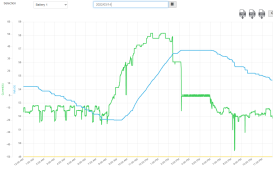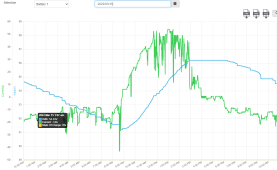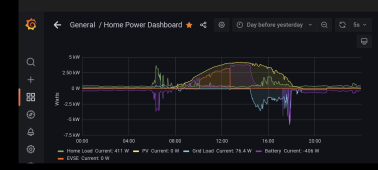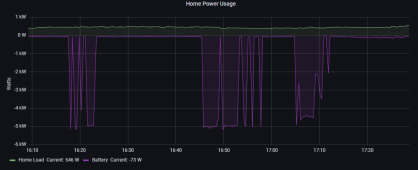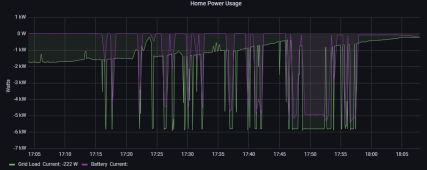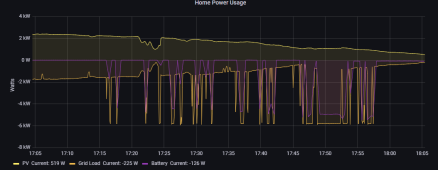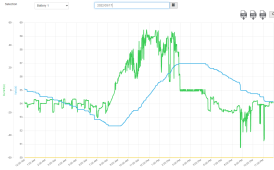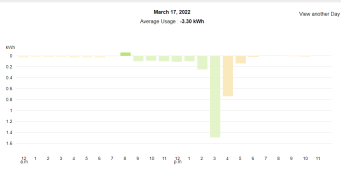For "Grid Tie" power, it is just hard to beat all the advantages of the Enphase setup. Especially with the "Rapid Shutdown" requirements, it really does not cost that much more than a string inverter now. But when you want to have batteries as well, it throws a wrench into the whole equation.
When I ordered my system back in May 2019, there was only basic info about the upcoming Enphase Ensemble battery system, and I had hoped it would be what I was expecting. It is an excellent system, and I think it has some great potential, but the actual installed cost is quite a bit more than I was hoping, and from "svetz" experience so far, it seems the peak current from the batteries is not quite hitting the mark. He has had several software updates and the system is working better. He is documenting his system very well on the thread "An Enphase Ensemble Installation". If I had bought new batteries, I would probably be close to the cost of the Enphase batteries. My biggest savings is I am installing the new inverter. The two contractors here who would install the new Empower batteries wanted WAY too much. I almost went with a Tesla Powerwall 2. It is about the best bang for the buck for a complete new storage system, but I ran into issue with wait times, and the certified installers did not want to work with someone else's existing solar install. And good luck buying one to install yourself.
After all the study I did, the Schneider XW hit most of the buttons. When they updated it to the "Pro" version, it greatly improved how it would work with Lithium batteries and Enphase micro inverters. And the programming options make it incredibly flexible for how it will manage my energy. It also has a hug 12,000 watt surge power, so I know it will start anything in my home. Then add in the great deal I was able to get on the surplus Chevy Bolt batteries and my out of pocket cost is quite good.
On the negative side, there are a few things that I do not have yet. The Schneider system is very modular. But that means you "buy" each module. Since I am starting with my existing Enphase micros, I will not have an MPPT solar controller. This is not an issue now, but I may add some DC couples panels to help charge the batteries. The Schneider MPPT units that link to the Xanbus data network are pretty expensive, at about $500 for the cheaper 60 amp 150 volt unit. And I also want to have the output track my current consumption to limit export to the grid while still powering the part of my home that is still in the main panel, but in it's standard form, it only measures the current in and out of the XW box. This can do "grid zero" for the loads in the backup essential loads panel, but not the load in the main panel. Since I have some major loads back in my main panel, it will not know how much power to send back out the input side without another 3rd party box with external current measurement CT's at my breaker panel. That adds another $600 or so. Since it is modular, I can add it later, and I probably will, but for now, I can tell it how many amps to export, but it won't dynamically adjust as loads change. Since I do have a net metering agreement, I am ok with it pushing up to 16 amps out of my house without being in violation, so this is fine, but not ideal. Once I add the "Watt Node" CT box, It can adjust every few second, so if my A/C kicks on during peak energy time, it can send stored battery power back to the main panel to run the A/C and still have zero power coming in or out from the grid, and when the A/C stops again, it will go back to charging the batteries from the solar power, leaving enough solar to still run my minor loads. The Outback Skybox has both an MPPT controller and the external CT inputs included. I almost went to it, and "Ampster" is using one with excellent results. He has some Enphase and Solar Edge both feeding into it. His latest thread on it is "AC coupling my Outback Skybox to a Solaredge inverter". Our systems are a bit different, but we are trying to do the same thing. The main plan is to store power when the solar makes more than we need, and then use that power when the sun goes down. With the basic control built into the Schneider XW-Pro, I hope to reduce what I export now to near zero, and run my house off the batteries for just the 5 hour slot where my utility SCE kicks the rate to $0.40 per KwH and then run on the $0.25 per KwH overnight so I have at least 40% of my battery left in case we have a power failure. I miss my old tiered rate plan when tier 1 was just $0.15, but now I make some of my own power, so SCE wants me to pay MORE!
We don't have many power failures here now, but I expect it is going to get worse. We had one 2 years ago that lasted 3 days when an underground cable failed. And with wild fires and earthquakes, it could get very bad. We have had quite a few glitches during the "Lake Fire", and only a few blocks away, a whole area went dead, cutting power to 300 homes for 2 days. The fire is still burning. Having the batteries will reduce the cost of power a bit with the "Time of Use" rates, but it really won't pay off the cost of the gear, so it is the backup power that makes it viable now. Grid Tie solar is the most efficient way to make sun into AC power, but if the grid goes down, it has to shut down as well. Once you have to shuffle power in and out of batteries, you lose some of the energy. Combining the Enphase micros and an AC coupled battery inverter/charger looks like a very good compromise. If I can get the system balanced well, the only energy I will shuffle on a daily basis with the grid up is just the extra solar that I am basically giving back to SCE for free now. They only pay a net $0.02 to $0.06 for extra pushed back on the grid, and charge up to $0.40 when I need to buy it back as the sun goes down. If I can store 8 KwH that I am now sending back to SCE and then use it during peak time could save me about $3.00 a day. That does not sound big until you do it 250 days of the year, and I could save $750. Being more realistic, I expect to save about $1.00 per day on average, which is decent. Even if it never pays for the batteries, I am still giving SCE less money, and I will have power during a blackout. I have seen my system push over 10 KwH back in Spring and Fall, but with my A/C cranking I sent none back 3 days ago. It all depends on how much sun the panels see, and how much power you actually use.
Under the current California rules, it is not legal to sell back power that you charged from the grid, you can only sell power that the solar panels made. This prevents people from storing a ton of power at $0.15 on the EV owner "Prime" rate, and selling it back during the peak $0.41 rate. But if you can show your solar panels made more than you sell them, it is still legal. in an AC coupled system like I will have with the Schneider and Enphase setup, it is impossible to know which electrons actually went into the battery. But I can easily show that my panels did produce 20-30 KwHs in a day on their report page, so as long as my export is well below the production, I am legal, and they can't say I am cheating. In a perfect world, I would export nothing, and use all my own power. It would be great to only export when the battery reaches full charge, with all my loads being powered, and I have no where else to send the extra power coming in from the panels. This probably won't happen often, but if it does, it means I need a bigger battery. The other issue is getting the XW to adjust it's charge/discharge to exactly follow my generation and usage. Without the WattNode installed, I know for sure it will over and under shoot quite a bit. But as long as I stay within my NEM agreement of less than 16 amps of export current and no more than 900 KwH's a month to the grid, I am legal. But the closer I can get it to follow my load, the more money it will keep me from sending to SCE.



